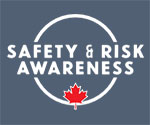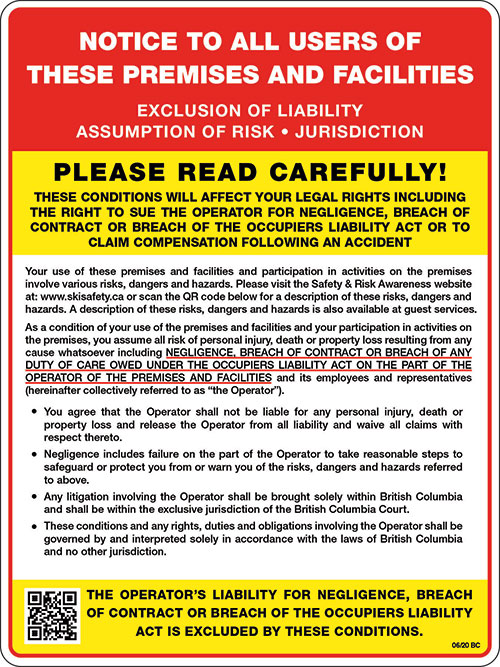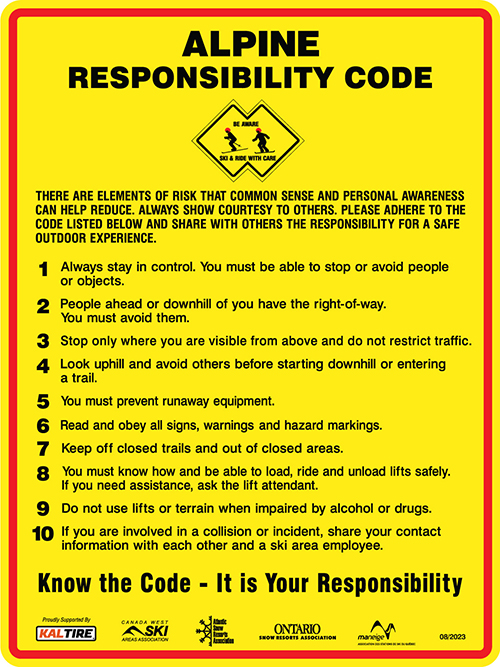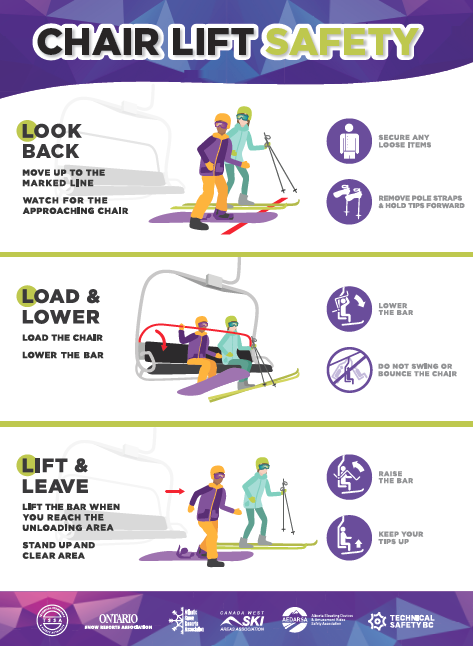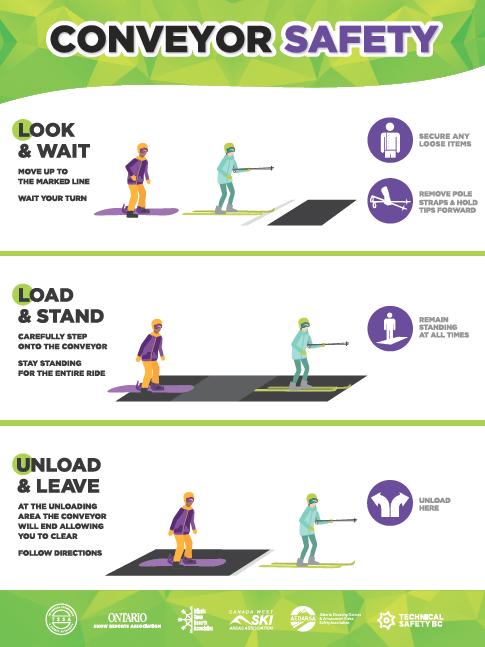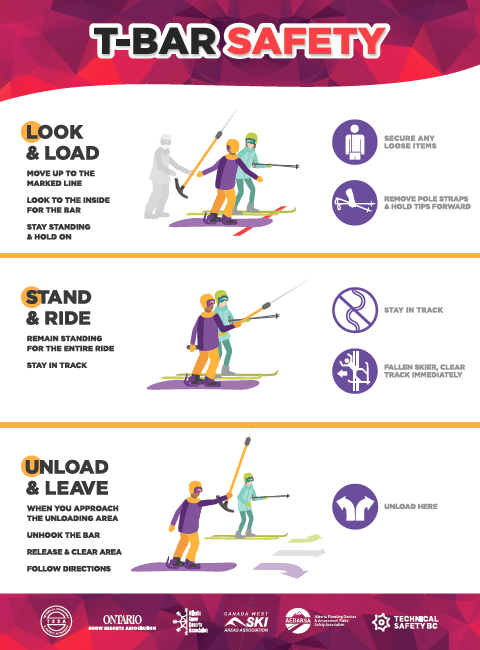Mountain Safety
PATROL - EMERGENCY: 250-491-6160
For all snow emergencies on mountain from 8am-5pm daily and during night skiing, contact patrol. All other emergencies call 911.
SAFETY & MOUNTAIN RISK AWARENESS
Big White has a commitment to safety for everyone using the resort. The responsibility codes are the basic rules of conduct and must be followed by all using the terrain. The information below is here to keep you and your loved ones safe while enjoying the slopes, please ski & ride with care and above all, have fun!
If you ever have a safety concern that is related to a non-emergency situation, please contact Paladin Security directly on 1-877-980-7550.
EXCLUSION OF LIABILITY - ASSUMPTION OF RISKS
The use of ski area premises and facilities and participation in activities at ski areas involves various risks, dangers and hazards. It is a condition of your use of the premises and facilities and your participation in these activities that you assume all risk of personal injury, death or property loss resulting from any cause whatsoever, including negligence, breach of contract, or breach of any duty of care on the part of the ski area operator. Your legal responsibility as a user of the ski area premises and facilities or participant in activities at the ski area is explained in the following notice, which you will see posted at the ski area.
Skiing, snowboarding, and cross country skiing (nordic) involves various risks, dangers and hazards including, but not limited to the following:
- Boarding, riding and disembarking ski lifts;
- Changing weather conditions;
- Avalanches;
- Exposed rock, earth, ice, and other natural objects;
- Trees, tree wells, tree stumps and forest deadfall;
- The condition of snow or ice on or beneath the surface;
- Variations in the terrain which may create blind spots or areas of reduced visibility;
- Variations in the surface or sub-surface, including changes due to man-made or artificial snow;
- Variable and difficult conditions;
- Streams, creeks, and exposed holes in the snow pack above streams or creeks;
- Cliffs; crevasses;
- Snowcat roads, road-banks or cut-banks;
- Collision with lift towers, fences, snow making equipment, snow grooming equipment, snowcats, snowmobiles or other vehicles, equipment or structures;
- Encounters with domestic and wild animals including dogs and bears;
- Collision with other persons;
- Loss of balance or control; slips, trips and falls;
- Accidents during snow school lessons;
- Negligent first aid;
- Failure to act safely or within one’s own ability or to stay within designated areas;
- Negligence of other persons; and NEGLIGENCE ON THE PART OF THE OPERATOR and its directors, officers, employees, instructors, agents, representatives, volunteers, independent contractors, subcontractors, sponsors, successors and assigns.
KNOW THE CODE
ALPINE RESPONSIBILITY CODE
The Alpine Responsibility Code provides the basic rules of conduct and must be followed by all using the terrain, and is consistent across all Ski Areas of Western Canada.
- Always stay in control. You must be able to stop or avoid people or objects.
- People ahead or downhill of you have the right-of-way. You must avoid them.
- Stop only where you are visible from above and do not restrict traffic.
- Look uphill and avoid others before starting downhill or entering a trail.
- You must prevent runaway equipment.
- Read and obey all signs, warnings and hazard markings.
- Keep off closed trails and out of closed areas.
- You must know how and be able to load, ride and unload lifts safely. If you need assistance, ask the lift attendant.
- Do not use lifts or terrain when impaired by alcohol or drugs.
- If you are involved in a collision or incident, share your contact information with each other and a ski area employee.
Also, be aware of the Cross Country Responsibility Code and Mountain Bike Responsibility Code.
KNOW THE CODE
BE SAFETY CONSCIOUS
IT IS YOUR RESPONSIBILITY
KNOW BEFORE YOU GO
TREE WELL SAFETY - WHAT TO DO
- Always ride with a buddy and stay within sight and earshot of each other
- Turn below trees not above them – avoid tree wells
- Don’t look where you don’t want to go
- Have a meeting place for if you and your partner get separated
- Always carry a cell phone and keep it charged and warm
- Carry a whistle and keep it easily accessible
- Yell or use a whistle to get your partner's attention.
- Keep your head above the surface of the snow and do whatever you can to achieve this including rolling, grabbing tree branches or the tree trunk. If possible, keep your feet below the level of your head.
- If you become immersed, make a space around your face and protect your airway but resist the urge to struggle, it could compromise your airspace and entrap you further.
- Stay calm to conserve air.
- Trust your partner is on their way.
- If possible, use your cell phone to call ski patrol at (250-491-6160). Save this number before you go out riding!
- Don’t leave to get help, stay with your partner
- Call for additional resources. Use a whistle or yell for assistance. If possible, call ski patrol or the resort's emergency phone number.
- Evaluate the scene safety for yourself.
- IMMEDIATELY begin snow immersion rescue efforts.
- Go directly for the airway, and keep it clear, be careful not to knock more snow into the hole. Clear any snow from the airway and continue necessary first aid or extrication efforts.
- Do not try to pull the victim out the way they fell in. Instead, determine where their head is and tunnel in from below.
- When tunnelling directly for the airway be careful not to knock more snow into the hole. Continue expanding the tunnel to the airway until you can extricate their body.
www.deepsnowsafety.org
A tree well is a hole or depression that forms around the base of a coniferous tree. The holes are formed when the low coniferous branches stop the snow from compacting and settling around the trunk. The hole is hidden from view from the other branches on the tree.
Tree Well Rescue
Point of clarification - This is real world stuff, raw and flawed. Everyone in this video is a recreational skier, an amateur in back country rescue. Even with a successful outcome, this rescue has mistakes and is not a representation of proper technique. The intent of this video is to demonstrate and educate people on the dangers of tree wells. NOT a demonstration on HOW to rescue someone from a tree well.
PERSONAL WELL BEING
Big White Ski Resort is dedicated to ensuring the safety and well-being of all guests. The responsibility codes serve as fundamental guidelines for conduct, here are some additional tips to help you stay comfortable and safe while enjoying the slopes.
- Wear a Helmet
- Big White Ski Resort recommends that all skiers and riders wear helmets. We recommend that everyone educates themselves in the uses, advantages and limitations of helmets.
- Protect Your Skin
- UV rays are reflected from the snow surface. Make sure to put sunscreen on exposed skin. Wear sunglasses or goggles to protect your eyes.
- Dress Appropriately
- Dress in layers so you can remove or add layers depending on your body temperature. The base layer should wick moisture away from your body. Synthetic fabrics that are specifically designed and merino wool make great base layers. Avoid cotton as it won’t keep you warm when wet. Middle layer – think insulation! Down vests, wool sweaters, fleece pullovers are all great options. Top layer should be wind and water resistant and breathable.
- Footwear
- Ski boots can be difficult to walk in and do not offer good traction. Use extra caution when walking around base areas.
- Stay hydrated; drink plenty of fluids (water, juice)
- Eat snacks & good meals
- Meeting points
- When skiing in a group, either with friends or family, make sure you have a designated meeting place. The meeting place should be a spot that everyone can easily find and access. If you become separated head to your designated meeting place.
- Ski with a friend, if you ski or ride with a buddy, it's much safer and usually more fun!
- Carry a whistle. A whistle blast can carry further than the human voice if you get into trouble in the trees.
- Carry a cell phone and keep it charged and warm
SLOW ZONES

Safety and education are always our priority at Big White Ski Resort and with that in mind ALL GREEN RUNS ARE SLOW ZONES. Thousands of people have had the opportunity to ski and ride our slow zones in comfort knowing those runs are designated for slow skiing and snowboarding.
In order to facilitate controlled, slow skiing and riding, please approach green runs slowly and with extreme caution. This allows our more senior guests as well as families and children to enjoy the mountain safely and at their own pace. The appropriate speed on these runs is the general flow of traffic. Skiers and Snowboarders who wish to overtake another skier/snowboarder may do so only if space permits, in a safe and controlled manner and while avoiding excessive speed.
Please Note: Skiers and Snowboarders caught skiing or riding in an uncontrolled and/or unsafe manner, or with excessive speed will result in the loss of their lift privileges for an indeterminate amount of time.
TERRAIN SAFETY
Patrol
The Patrol at Big White Ski Resort is made up of Paid Patrollers and volunteer patrollers from Canadian Ski Patrol (CSP). During day skiing hours you can find patrollers at the top of the Alpine T-bar, Gem Lake Express and in the main Patrol Hut near the bottom of the Ridge Rocket Express. During night skiing, patrollers are located at the top of the Bullet Express. Big White Ski Resort is a 911 community. Patrol can be reached at 250.491.6160.
Avalanche Prevention and Control
Weather forecasting, snowpack monitoring and avalanche control is a 7 day a week job on our local mountains.
Snowmobiles
Be aware that snowmobiles are part of our daily operation. Snowmobiles use designated routes. If you encounter a snowmobile slow down and give the snowmobile lots of space.
Snow Conditions & Visibility
Big White Ski Resort is located in a high alpine mountain environment. The weather conditions can change quickly. Check weather forecasts and watch the environment around you. Visibility can be compromised by variable cloud. Marker poles have been placed in above treeline locations to assist in getting down the runs. Yellow or amber lenses in goggles can help add definition to snow covered terrain.
Skier/Rider Safety
All skiers and riders must always be in control on the mountain. Green runs are beginner areas. All skiers and riders should slow down on green runs to provide a safe learning environment for beginners.
Injured Guests
If a member of your party is injured or you come across an injured guest mark the site using the injured persons skis or snowboard. Put skis up in an X or lay the snowboard, bindings down and perpendicular to the run. Make a note of where the injured guest is, what the suspected injury is, gender and approximate age of the guest, take this information to the nearest resort employee or call Patrol at 250.491.6160.
Misplaced Guests
If a member of your party becomes lost, contact any resort employee to help you. You will need the following information about the person for Patrol: name, gender, age, what they are wearing and where they were last seen. If you know their cell number or if they have a season pass is also very helpful. Remember to go to the designated meeting place and wait for them there.
Early Season/Marginal Conditions
Natural and man-made hazards will be encountered. This designates very difficult conditions.
SIGNS AND NAVIGATING THE MOUNTAIN
The designation of run difficulty is set by each area individually. There are some broad guidelines to assist area operators in designating the difficulty of the runs. The first time to a resort start with the green designations and get a feel for how the difficulties are rated.
The run signage is set up in a way for easy navigation of the mountain.
- The top run on the sign is the run you are on.
- The subsequent signs are the other runs that you will encounter on the main run, in order
- The bottom of the sign will show the easiest way to the bottom of the lift or to the nearest base area.

![]() Green Circle – The easiest runs on the mountain. Green runs are groomed, generally wide and have gentle slopes. On green runs when there is a steeper pitch, the pitch is wide to allow for big turns. Great green runs at Big White are; Millies Mile, Sundance and Squirrel.
Green Circle – The easiest runs on the mountain. Green runs are groomed, generally wide and have gentle slopes. On green runs when there is a steeper pitch, the pitch is wide to allow for big turns. Great green runs at Big White are; Millies Mile, Sundance and Squirrel.
![]() Blue Square – This category has the greatest variation in runs, these runs are more difficult. Blue runs can be groomed or ungroomed. Easier blue runs at Big White can be found on the Black Forest Express, harder blue runs can be found on the Ridge Rocket Express, Powder Chair and Gem Lake Express.
Blue Square – This category has the greatest variation in runs, these runs are more difficult. Blue runs can be groomed or ungroomed. Easier blue runs at Big White can be found on the Black Forest Express, harder blue runs can be found on the Ridge Rocket Express, Powder Chair and Gem Lake Express.
![]() Black Diamond – These runs are the most difficult, generally ungroomed, steeper and narrower. Before attempting black runs, people should be comfortable with ungroomed blue runs.
Black Diamond – These runs are the most difficult, generally ungroomed, steeper and narrower. Before attempting black runs, people should be comfortable with ungroomed blue runs.
![]() Double Black Diamond – These runs are the most difficult expert terrain on the mountain. This terrain is steep, has narrow chutes and is in avalanche terrain. This terrain can only be accessed through open gates.
Double Black Diamond – These runs are the most difficult expert terrain on the mountain. This terrain is steep, has narrow chutes and is in avalanche terrain. This terrain can only be accessed through open gates.
Red – Shows the easiest way to the bottoms of lifts and base areas.
BOUNDARY & SIGNS
Avalanche Canada & Area Boundaries
- Avalanche Canada Center
- Avalanche Canada is a non-government, not for profit organization dedicated to public avalanche safety. It came into existence in 2004 with the support and collaboration of federal, provincial and private sector agencies involved in avalanche safety.
- For the current avalanche bulletin for outside our area boundary please check: www.avalanche.ca. Big White Ski Resort is located in the Kootenay Boundary Forecast Region.
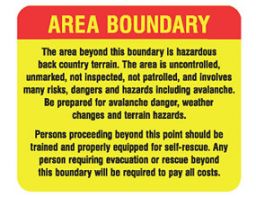
- Area Boundary, Out of Bounds – Our area perimeter boundary is clearly marked.
- The area beyond this boundary is hazardous backcountry terrain. The area is uncontrolled, unmarked, not inspected, not patrolled and involves many risks, dangers and hazards including avalanche. Be prepared for avalanche danger, weather changes and terrain hazards. Persons proceeding beyond this point should be trained and properly equipped for self-rescue. Our boundary perimeter is clearly marked with ropelines and signs in the alpine and placards on the trees on the lower mountain.
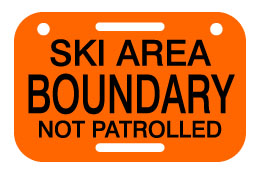
- In Bounds Avalanche Terrain – Within our area boundary we have avalanche terrain.
- This terrain has a permanent ropeline and avalanche flip signage. Our avalanche terrain must be accessed through open gates only. This terrain may open or close at any time due to conditions. Anyone caught in closed avalanche terrain will have their passes revoked for an indeterminate amount of time.
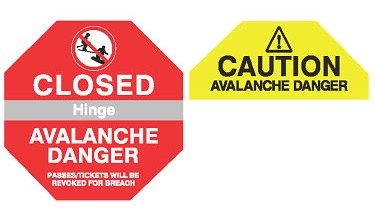
LIFT SAFETY
To travel uphill at Ski Areas, skiers and snowboarders use a variety of ski lifts. Users should be familiar with the use of lifts for their own safety and the safety of others.
There are many signs on and around ski lifts. Each is important in its own right, informing you about the process for loading, riding, and unloading the chair. Pay attention to and obey these signs when riding a chairlift. If you are unfamiliar with a lift or have questions, please ask a lift attendant for assistance and directions. Ski and snowboard lessons are also great ways to learn about using the ski lifts.
- You must have sufficient physical dexterity, ability and knowledge to safely load, ride and unload lifts. If in doubt, ask the lift attendant
- You must not use lifts or terrain if you are impaired through use of alcohol or drugs
- Remove pole straps from wrists, hold poles with tips forward
- Secure loose items – make sure you don’t have anything that can catch on the carrier (zippers, strings, hair)
- If carrying a backpack, it must be removed and held on your lap while on the lift (infant front carriers and child backpack carriers are not permitted on the lift)
TIPS FOR RIDING SKI LIFTS
- Read lift signage
- Make sure loose items are secure
- Fold down highback bindings
- Remove backpacks
- Ask for help from the lift attendant if unsure
- Wait for load gates or follow chair through station, stop at load here marker
- Lower the restraining bar
- Single riders sit in the middle of the chair
- Do not swing or bounce chair while riding
- Do not jump from chair
- Lift restraining bar prior to entering the station, make sure everyone is sitting back in the chair
- Prepare to unload
- Keep ski and snowboard tips up
- Stand at the Unload Here sign
- Move away from the unload area
- Ask lift attendant for help retrieving dropped items
- Read lift signage
- Secure loose items
- Ask for help from the lift attendant if unsure
- Wait for your turn
- Move forward onto conveyor
- Leave sufficient space between you and the person in front of you
- Remain standing at all times
- Prepare to unload
- Move away from unload area
- Read lift signage
- Secure loose items
- Ask for help from the lift attendant if unsure
- Remove ski poles, hold in outside hand, tips pointed forward
- Look over inside shoulder
- Remain standing
- Stay in track
- If you fall, clear track quickly
- Prepare to unload
- One rider takes T
- Slowly release T
- Clear unload area
LIFT EVACUATION TRAINING
Lift evacuation training at Big White Ski Resort is a vital component of the ski patrol’s preparedness, ensuring the safety and well-being of all guests in the rare event of a lift emergency. This comprehensive training equips ski patrol members with the technical skills and confidence to safely and efficiently evacuate individuals from chairlifts. The program includes hands-on practice with specialized equipment, such as ropes, harnesses, and rescue chairs, as well as scenario-based drills to simulate real-life conditions. By mastering these essential skills, ski patrol is prepared to act swiftly and effectively, minimizing risk and maintaining the resort's commitment to guest safety.
NO DRONES, UAV, SKI BIKES, TOBOGGANING ON RUNS, UPHILL ACCESS AND INFO
RESTRICTIONS
Drones, Ski Bikes and Tobogganing on runs are restricted at Big White Ski Resort.
Public Unmanned Aerial Vehicle/Drones Usage Policy
Out of safety concerns for guests, employees, and resort property, Big White Ski Resort prohibits the operation or use of unmanned aerial vehicle systems, or aerial drones, by the general public including recreational users and hobbyists.
This prohibition includes drones used for any purpose, including but not limited to: filming or videotaping, still photography, mapping, as well as any drone use by media or journalists operating above or within Big White Ski Resort boundaries.
This prohibition on drone use extends to any drones launched or operated from Resort property, as well as drones launched from private property outside of the Resort boundaries.
Please contact Big White Ski Resort if you have any questions.
Ski Bike usage on mountain is restricted
Currently we do not allow ski bike lift access on the mountain. For a few reasons.
- Our lift system is not operationally set up to load and unload foot passengers. Ski bike riders are viewed as foot passengers.
- We are not comfortable with a ski bike riders ability to avoid others while on the mountain. This is a requirement taken directly from the Alpine Responsibility Code.
- If a collision with another guest should occur, the frame of a ski bike may become entangled with both parties involved causing increased undo injury.
- The weight of some ski bike designs plus the weight of the rider is quit substantial. This increased weight may add to the serious of an injury during a collision.
Big White does allow fat bikes(fat bicycle tires designed for winter) but only on the designated Nordic trails in the Happy Valley area. They are not allowed to load the lifts or on downhill runs. Snowbikes are not allowed on the runs the lifts or anywhere else on the runs. Snowbikes look like a bike frame but with skis instead of tires.
Mini Skis, Sled Dogs, Snow Feet and any other products like it are NOT PERMITTED on the runs and are not permitted to use the ski lifts. Snow Blades are permitted.
No Tobogganing on ski runs
Ski runs are accessed by skiers, snowboarders and foot traffic. For the safety of our guests, tobogganing on ski runs is prohibited. Toboggans are not allowed on any lifts.

Dogs and Other Pets
Big White is a very dog friendly community. It is NOT PERMITTED to ski or snowboard downhill with your pet either in a back pack or running beside you. This is for guest and pet safety. Please always keep your pets on a leash, under control and clean up after them. Dogs are only permitted on Lara’s Gondola. Please do not attempt to load any other lift with your pet.
Infant front carriers and child backpack carriers are not permitted on the lifts or while skiing, snowboarding or tubing.
Winter - Uphill Access/Touring Policy
Once the snow flies at Big White, there is absolutely NO uphill access within our downhill ski area boundary, during or outside of our operational hours. This includes, but is not limited to: touring skis, split boards, snowshoeing, snowmobiling, cross country skiing, or travel by foot.
There are no designated uphill access routes. We take guest and worker safety very seriously, and the potential risk of an incident involving uphill and downhill traffic within our ski area is significant. Outside of operational hours we have machines operating all over the mountain that are not on the lookout for pedestrian traffic. Violators of this policy may be subject to consequences including pass suspension.
COMMUNITY POLICE
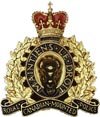
CPO will be open Sundays, Tuesdays, Thursdays 1:30 p.m. to 4:00 p.m during the winter season.
CPOs are staffed by volunteers from the community. Members of the public attending at these offices may receive assistance in reporting minor offences, dealing with police members or getting information relating to crime prevention and community policing concerns. It is closed Christmas and New Years days.
Location: The office is located in Whitefoot Lodge and is accessed from the deck past the Globe restaurant.
Volunteers complete reports of thefts and/or losses that happen at the resort. These reports are filed with the RCMP and generate file numbers that are available to the victims/complainants for insurance purposes.
Volunteers also offer free ski and board engraving as a theft deterrent. Skiers and boarders are encouraged to take their equipment and driver’s license to the CPO. The number on their license, which is traceable by all police departments, is engraved in a discrete location on their equipment. Stickers indicating the equipment is part of the Ski Watch program are applied to deter theft, if the skier/boarder wishes.
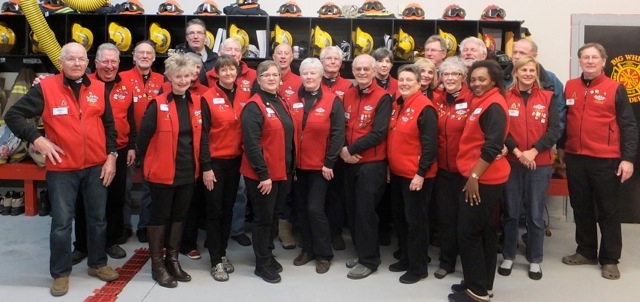
Members of the RCMP often use the CPO as a base of operations when performing police work in the resort. They also have an on-mountain presence, skiing or boarding in brightly coloured jackets. They are available to interact with members of the public in an informal way and help maintain a safe and secure environment for skiers and boarders.
Contact Information:
SMOKING POLICY
Enjoy the fresh air. Big White Ski Resort is a smoke-free environment.
To keep our alpine air clean and to protect our natural environment from dangerous forest fires, smoking of any kind (including tobacco, marijuana, e-cigarettes and vaporizers) is strictly prohibited anywhere on Big White Ski Resort property outside of designated smoking areas. Our policy applies to both the summer and winter seasons.
This includes:- All chairlifts and gondolas
- Lift lines
- Ski runs
- Happy Valley Adventure Park
- Nordic trails
- Bike Big White trails
- Hiking trails
- Village property outside of designated smoking areas
- Within or near building entrances and intakes
- The Woods patio
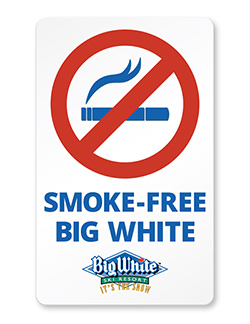
Thank you for your cooperation and your consideration of other guests.
Please note, Big White Ski Resort’s smoke-free policy does not apply to the patios and/ or common property of private businesses located on Big White Ski Resort property such as Globe Café & Tapas Bar, The BullWheel and Snowshoe Sam’s.
